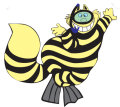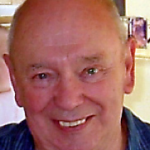This is the third installment in the series of articles from Alan Haywood, one of the clubs early members. You can see the full series of articles here.
Chapter three, ECSAC, New Friends and Diver Training. The early days of ECSAC
My long association with ECSAC started in a Brewery! Cornbrook Brewery, Chester Road, Manchester
I was a contractor, employed to modernise the electrical installation and provide automated control of the brewing system, which was almost Dickensian in principal with 1930’s electrical switchgear.
The Head Brewer, Richard Hyde, was one of the family of brewers responsible for all the famous beers available in the Manchester area, headed by Richard’s uncle at Chester’s Brewery adjacent to Strangeways Prison.
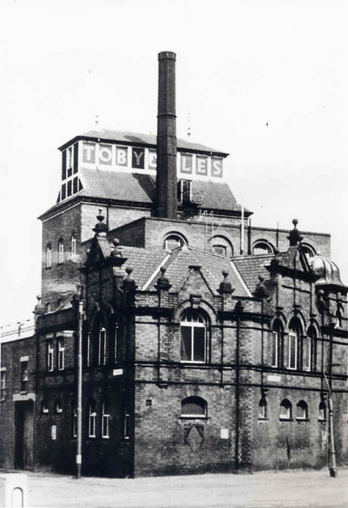 Richard’s assistant brewer Neville Sheard had just returned from Sri Lanka (Ceylon in those days) where he was Head Brewer at Nuwara Eliya brewery. We worked together and talked about diving and the fantastic visibility in The Indian Ocean. He had dived with Arthur C Clark several times including several visits toThe Great Basses Reef Silver Wreck and the Huge floating dock in Trincomalee Harbour which sank during pumping operations. The dock was involved with repairs to HMS Valiant, she had a full load of ordnance in the stern, normally maximum weight would be amidships. The centre tanks of the dock were pumped assuming normal weight distribution, the dock broke it’s back and started to sink. Fortunately, Valiant still had a full head of steam and the crew managed to manoeuvre her out of the dock. However, one of her propellers was damaged as the dock sank and she had to limp back to the UK for repairs.
Richard’s assistant brewer Neville Sheard had just returned from Sri Lanka (Ceylon in those days) where he was Head Brewer at Nuwara Eliya brewery. We worked together and talked about diving and the fantastic visibility in The Indian Ocean. He had dived with Arthur C Clark several times including several visits toThe Great Basses Reef Silver Wreck and the Huge floating dock in Trincomalee Harbour which sank during pumping operations. The dock was involved with repairs to HMS Valiant, she had a full load of ordnance in the stern, normally maximum weight would be amidships. The centre tanks of the dock were pumped assuming normal weight distribution, the dock broke it’s back and started to sink. Fortunately, Valiant still had a full head of steam and the crew managed to manoeuvre her out of the dock. However, one of her propellers was damaged as the dock sank and she had to limp back to the UK for repairs.
In the 1990’s Hugh Kidd and I went to Sri Lanka en-route to The Maldives. We planned to dive Trincomalee, but unfortunately travel was not possible in the North of the country due to activity in the area by The Tamil Tigers.
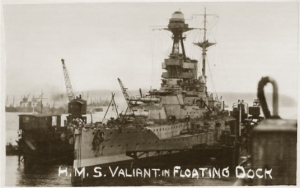 Neville Sheard lived in Disley and on a sightseeing trip around Cheshire with wife Carol called at The Highwayman to sample the local beer! They talked with the Landlord Neville Oldham, the conversation quickly turned to diving and the ECSAC based in Macclesfield. A week later we went to Macclesfield Baths on Thursday night, Neville was not there but we met Ken Jores, Diving Officer and joined the club that night.
Neville Sheard lived in Disley and on a sightseeing trip around Cheshire with wife Carol called at The Highwayman to sample the local beer! They talked with the Landlord Neville Oldham, the conversation quickly turned to diving and the ECSAC based in Macclesfield. A week later we went to Macclesfield Baths on Thursday night, Neville was not there but we met Ken Jores, Diving Officer and joined the club that night.
I note in my log book Ken signed completion of the swimming test (Group A) February 1964, the night we joined. There was not much open water activity from February to Easter. Then several members including the diving officer, Training Officer, Steph Wallbanks and Equipment officer, Pete Smith went to Lamorna Cove and pitched their tents at “The Wink” (Local name for The Lamorna Inn). Pete Smith had problems with his valve so borrowed my Mistral twin hose valve, I hated these new fangled two stage single hose things and refused to change for several years.
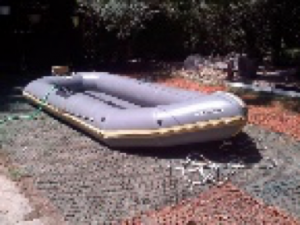 The branch at that time had an inflatable boat. An Avon Redshank 12-foot dinghy with soft rubber floor and a detachable outboard bracket. The star and court jester of the branch was Pat Heron, he provided, on loan, a Seagull 5HP single cylinder outboard motor.
The branch at that time had an inflatable boat. An Avon Redshank 12-foot dinghy with soft rubber floor and a detachable outboard bracket. The star and court jester of the branch was Pat Heron, he provided, on loan, a Seagull 5HP single cylinder outboard motor.
I completed my training to Group F by end April 1964 and third-class diver by end July 1964. Open water diving training to this stage was in fresh water. The Blue Pool at Llangollen was the most accessible A flooded slate quarry at the top of the Horseshoe Pass it was 20metres deep with brilliant visibility at all times an old morris car on the bottom and cliffs all round to carry out your three jumps into open water. I don’t think the water temperature ever reached 8 degrees.
Another site was The Road Bridge at Kirkby Lonsdale, A 15 metre hole in the River Lune, this was used by members of NORFED (The Northern Federation of Diving Clubs) who had arranged permission to dive the site with the local authority. The only regulation was “No diving knives allowed in the water”. We frequently had to break an entry hole through the ice to get into the water, but in winter the fish life was wonderful, groups of salmon and trout waiting for a spate to progress upstream to spawn. The salmon put their heads into hollows between rocks. (Ostrich like, I can’t see you so you can’t see me). I developed a technique of gently stroking the fish then lifting them slowly out of the hole, a bit like stroking trout to catch them. I 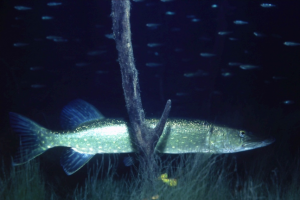 developed this to stroking Pike in Stoney Cove to get better photographs. Later to stroking plaice and even Monkfish off the Devon coast, although I found a large Monkfish off The Eastern Black Stone one day, touched it and it turned to face me and opened it’s mouth! I thought I was looking into The Mersey Tunnel. I then realised I had approached it on the side of a missing eye. You can do it with Moray Eels too if you talk to them while doing it!!!
developed this to stroking Pike in Stoney Cove to get better photographs. Later to stroking plaice and even Monkfish off the Devon coast, although I found a large Monkfish off The Eastern Black Stone one day, touched it and it turned to face me and opened it’s mouth! I thought I was looking into The Mersey Tunnel. I then realised I had approached it on the side of a missing eye. You can do it with Moray Eels too if you talk to them while doing it!!!
My first sea dives with the branch took place in July 1964 at Treaddur Bay, The Lily Pond. Shore dives of course, the club boat was still at Lamorna and The Diving Officer was on holiday. It was September 1964 before I reached Lamorna Cove with several branch members and had my first boat dive. First, we all had a shore dive! This consisted of a 500-metre snorkel to Woodcutters Rock, in a lee of Carne Du, the headland at the Northern end of the bay. Dive there and return on a compass bearing underwater to the jetty at the head of the cove. Given fair weather the Viz is usually good and the exercise sets you up for the boat dives.
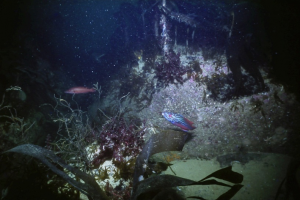 The Redshank carried six divers and a coxswain. All divers entered the boat fully kitted including weight belts., there was no room to fit into gear at sea. The most popular sites were the inner and outer Buck Rocks, approximately 2 km from the jetty. Both are half tide rocks, at high tide Inner Buck depth15 metres Outer 45 metres distance off shore 200 metres. During the diver, the coxswain follows bubbles for three pairs of divers for the duration of the dive, surface marker buoys were not used at this time. On completion of the dive, equipment removed and laid carefully on the rubber deck, divers climb aboard and boat returns to pick up the next party of six divers. Two people as shore covers were positioned on shore adjacent to the site.
The Redshank carried six divers and a coxswain. All divers entered the boat fully kitted including weight belts., there was no room to fit into gear at sea. The most popular sites were the inner and outer Buck Rocks, approximately 2 km from the jetty. Both are half tide rocks, at high tide Inner Buck depth15 metres Outer 45 metres distance off shore 200 metres. During the diver, the coxswain follows bubbles for three pairs of divers for the duration of the dive, surface marker buoys were not used at this time. On completion of the dive, equipment removed and laid carefully on the rubber deck, divers climb aboard and boat returns to pick up the next party of six divers. Two people as shore covers were positioned on shore adjacent to the site.
This worked well, until membership grew, and diving took all day. The answer was, drop divers at site, coxswain returns and picks up six more and returns to site, by which time the original six have surfaced and will return in the boat to the cove, pick up another six and so on. Everybody is briefed “if the boat engine fails or another problem occurs swim to the shore and walk back to the cove”.
Air was available at Blewitt and Pender’s in Penzance, volunteers took bottles the 12-mile round trip usually twice daily. Here we met John Rhodes who several years later negotiated the purchase of our first Air Compressor “The God”
At this time the branch had no permanent base, committee meetings were held in members homes, training lectures were held in pubs and equipment was kept at home by the equipment officer. Then we investigated ownership of an old wartime decontamination shelter on waste ground behind Frost’s Mill in Bank Street. Ken Jores was employed by Macclesfield Council as an Architect and traced the ownership to Frost’s. Our Chairman Stewart Davidson, Ken and I attended a meeting with the board of directors of Frost’s and after lots of “what ifs, who will carry out alterations and we will charge you”, a rent was agreed and we started the mammoth task of what we now have, with lots of great times, building a bar out of an old boat and getting a drinks licence. We had already discovered Sneaky Pete (Cornbrook Keg Bitter) and drunk gallons of it at beach barbeques around Wales. Neville Sheard arranged a bar type dispensing outlet on a short length of copper pipe fixed to the keg connector. Every club weekend was attended by a 9 gallon (72 pints) of keg beer together with the cylinder of CO2 to dispense it. It was christened Sneaky Pete because the after effects were delayed!!!!! We could not charge people for this because of licence problems, Neville and I bought it and asked for donations to club funds.
I’ll tell you more next week.
Read the other episodes here.
